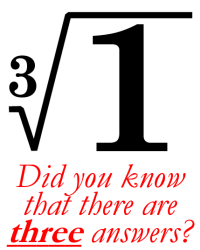 Thinking back on your math classes, you may recall that the square root of a number has two answers, one positive and one negative. For example, the square root of +9 is both +3 and -3 (the first one is known as the principal square root). Squaring +3 gives you +9, of course, but so does squaring -3.
Thinking back on your math classes, you may recall that the square root of a number has two answers, one positive and one negative. For example, the square root of +9 is both +3 and -3 (the first one is known as the principal square root). Squaring +3 gives you +9, of course, but so does squaring -3.
Square roots aren’t the only roots of a number. For example, the (principal) cube root of +8 is +2 because +2³ = +2 × +2 × +2 = +8.
But just as square roots have two answers, cube roots have three (and fourth roots have four and so on and so on).
 Five years ago today I posted,
Five years ago today I posted, 












